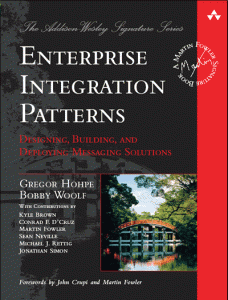For anyone who wants to start an integration project and who has not come across Enterprise Integration Patterns by Hohpe and Woolf – Stop! I would highly recommend reading this book first, or at the very least visit the website:
 http://www.enterpriseintegrationpatterns.com/
http://www.enterpriseintegrationpatterns.com/
One of the aspects of this book I really like is the ‘Gregor-grams’, which are symbols representing the particular patterns described, here is an example:
and this is what it says: a document messages is transformed, enriched and sent to a pub-sub channel. You can get these as a Visio template (see website above) and I find this really useful, not only as a source of symbols, but as a recipe book for integration.
Don’t get me wrong, I’m not saying this is the only way to approach integration work: the Gregor-grams are focussed on messaging solutions and don’t cover database, file or screen integration; you are also likely to need other views of the integration, e.g. from a user (actor) perspective or a view of the technology stack.
Gregor-grams do make a great part of the toolkit and if we all use them it will be easier for those inheriting our designs to understand them.
![2012.01.13 [IMG_8794]](https://www.gimeno.eu/wp-content/uploads/2013/09/2012.01.13-IMG_8794.jpg)

 Follow
Follow


![2013.01.01 [IMG_0098]](https://www.gimeno.eu/wp-content/uploads/2013/09/2013.01.01-IMG_0098-300x100.jpg)